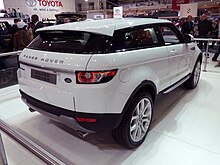 | |
| Manufacturer | Land Rover |
|---|---|
| Production | 2011- |
| Assembly | Halewood, England |
| Class | Compact crossover SUV |
| Body style | 3-door SUV 5-door SUV |
| Layout | F4 layout FF layout |
| Engine | 2.2 L I4 diesel 150 hp (110 kW) / 190 hp (140 kW) |
| Transmission | 6-speed Getrag M66EH50 manual |
| Wheelbase | 2,660 mm (104.7 in)[1] |
| Length |
3-door: 4,355 mm (171.5 in)[1]
5-door: 4,365 mm (171.9 in)[1] |
| Width | 1,965 mm (77.4 in)[1] |
| Height |
3-door: 1,605 mm (63.2 in)[1]
5-door: 1,665 mm (65.6 in)[1] |
| Kerb weight |
1,595 kg (3,516 lb) (Base 3-Door 2WD 2.2L)
1,640 kg (3,616 lb) (Base 3-Door 4WD 2.0L)1,625 kg (3,583 lb) (Base 5-Door 2WD 2.2L) 1,670 kg (3,680 lb)[2] (Base 3-Door 4WD 2.0L) 1,670 kg (3,682 lb) (Base 3-Door 4WD 2.2L) 1,700 kg (3,748 lb) (Base 5-Door 4WD 2.2L) |
| Related | Land Rover Freelander |
| Designer | Gerry McGovern |
LRX concept vehicle
The Evoque was developed from the LRX concept vehicle with the goal of producing a smaller more environmentally conscious vehicle. The size of the LRX complemented a wide array of efficiency improving technologies in the form of Land Rover’s e_Terrain technologies. These included biofuel compatibility, lightweight construction materials and technologies such as the removable carbon compositeroof panels, regenerative brakes, a stop-start system, and the ERAD (electric rear axle drive) parallel hybrid powertrain system.[5]
The ERAD system could propel the LRX to speeds of up to 20 mph (32 km/h) before the engine was started by an integrated starter generator as part of the stop-start system. ERAD was designed to reduce CO2 emissions by an average of 20 percent under the NEDC test cycle and was expected to offer another 10 percent reduction in extra-urban driving situations while also optimising the off-road ability of the vehicle. Land Rover aimed to achieve 120 g/km CO2 emissions and fuel economy of 60 mpg-imp (4.7 L/100 km; 50 mpg-US) on the European combined cycle with an efficient 2.2-litre turbodiesel engine.[6] The engine would become the only four-cylinder vehicle in the Range Rover lineup.
The latest incarnation of Land Rover’s acclaimed Terrain Response system was also included offering sport and eco modes in addition to the existing grass, gravel, snow, and sand modes. Typical Land Rover design traits aim at improving off-road performance included a prominent driving position, hill descent control, and useful approach and departure angles. A Land Rover first was an air intake system integrated into the roof which offered exceptional wading capabilities though this feature did not make it to the production model. Land Rover's Range Rover styling was visually apparent in the form of the clamshell bonnet, the ‘floating’ roof, dual-pocket headlamps, and raked roof line.
Interior design improvements were another main focus of the LRX concept though the interior of the production Evoque changed significantly from the concept LRX. Notable interior features in the LRX included ambient interior lighting that changed according to Terrain Response settings, and vehicle data which was presented to the driver through a ‘floating’ three-dimensional LCD display. An aluminium centre console with an iPhone docking station stretched the length of the cabin, separating the four seats and the tailgate. Seats with open frameworks were used to give the impression of an airy interior while also creating useful under-seat and under-floor stowage areas. Electric motors folded the rear seats forward providing enough room for two mountain bikes to be fitted upright, with front wheels removed and stored in dedicated slots in the floor.[6]
Specifications
Overview
The Evoque departs from the classic body on frame design used by the majority of vehicles designed for off road use. Instead the Evoque features a more modern unibody construction technique for improved handling and ride quality, and to appeal to buyers who drive primarily on road. Despite a lack of traditional body on frame construction and dedicated transfer case, the Evoque is still capable of class leading off road performance with 215 millimetres (8.5 in) of ground clearance, 25 degree approach and 33 degree departure angles, and the ability to ford up to 500 millimetres (19.7 in) of water.[1]
The manufacturer's fuel economy estimates for the 2.2-litre diesel engine with manual transmission are 47.1 miles per imperial gallon (6.00 L/100 km; 39.2 mpg-US) urban and 56.5 miles per imperial gallon (5.00 L/100 km; 47.0 mpg-US) combined, with CO2 emissions of 133 g/km.[1] For the 2.0-litre petrol engine with automatic transmission the figures are 23.7 miles per imperial gallon (11.9 L/100 km; 19.7 mpg-US), 32.5 miles per imperial gallon (8.69 L/100 km; 27.1 mpg-US) and 199 g/km CO/2.[1] United States Environmental Protection Agency fuel economy estimates have been stated as being 19 miles per US gallon (12 L/100 km; 23 mpg-imp) in the city and 28 miles per US gallon (8.4 L/100 km; 34 mpg-imp) highway for the 2-litre petrol version.[8]



Tidak ada komentar:
Posting Komentar